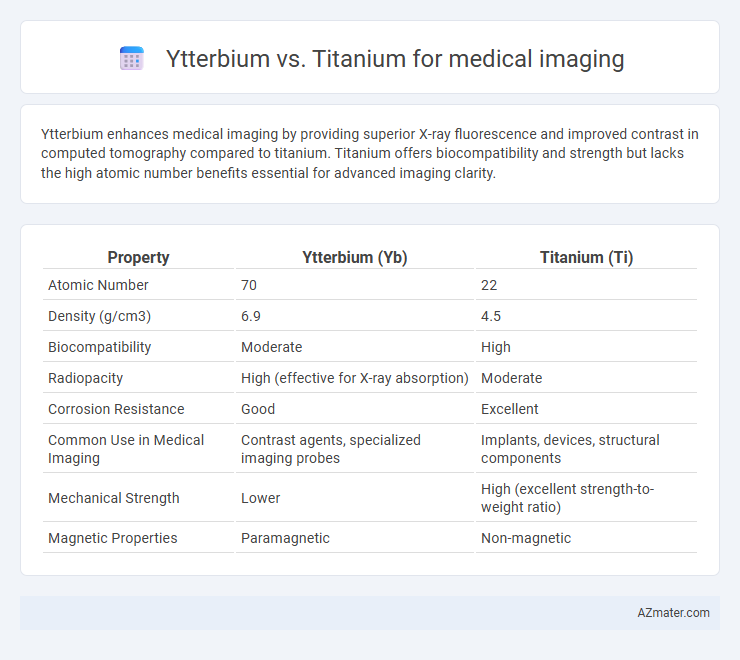Ytterbium enhances medical imaging by providing superior X-ray fluorescence and improved contrast in computed tomography compared to titanium. Titanium offers biocompatibility and strength but lacks the high atomic number benefits essential for advanced imaging clarity.
Table of Comparison
| Property | Ytterbium (Yb) | Titanium (Ti) |
|---|---|---|
| Atomic Number | 70 | 22 |
| Density (g/cm3) | 6.9 | 4.5 |
| Biocompatibility | Moderate | High |
| Radiopacity | High (effective for X-ray absorption) | Moderate |
| Corrosion Resistance | Good | Excellent |
| Common Use in Medical Imaging | Contrast agents, specialized imaging probes | Implants, devices, structural components |
| Mechanical Strength | Lower | High (excellent strength-to-weight ratio) |
| Magnetic Properties | Paramagnetic | Non-magnetic |
Introduction to Medical Imaging Materials
Ytterbium and titanium are prominent materials used in medical imaging due to their unique properties; ytterbium, with its high atomic number, offers enhanced X-ray absorption and contrast in computed tomography (CT) scans, improving image clarity. Titanium's biocompatibility, strength, and corrosion resistance make it a preferred choice for implants and devices that can be safely imaged without artifacts in magnetic resonance imaging (MRI). The selection between ytterbium and titanium depends on the specific imaging modality and clinical application, balancing imaging performance and patient safety.
Overview of Ytterbium and Titanium
Ytterbium and Titanium are both critical materials in medical imaging due to their unique properties. Ytterbium, a rare earth element, is valued for its high atomic number and favorable X-ray absorption characteristics, making it effective in contrast agents and imaging markers. Titanium, known for its biocompatibility, mechanical strength, and corrosion resistance, is widely used in medical implants and imaging devices, ensuring safety and durability during diagnostic procedures.
Physical Properties Comparison
Ytterbium and titanium differ significantly in their physical properties relevant to medical imaging; ytterbium, a heavy rare earth metal, has a high atomic number (70) and density, providing superior X-ray attenuation, which enhances contrast in CT imaging. Titanium, with an atomic number of 22 and lower density, offers excellent biocompatibility and mechanical strength but less effective X-ray absorption compared to ytterbium. These contrasting physical characteristics make ytterbium-based contrast agents more effective for imaging, while titanium is preferred for implantable medical devices due to its durability and compatibility.
Biocompatibility in Medical Applications
Ytterbium nanoparticles exhibit superior biocompatibility in medical imaging due to their low toxicity and favorable stability in biological environments compared to titanium-based materials. Titanium offers excellent biocompatibility primarily attributed to its well-established use in implants, but its imaging contrast efficiency is lower than that of ytterbium, which can enhance X-ray and CT imaging due to its high atomic number. The choice between ytterbium and titanium hinges on balancing biocompatibility with imaging performance, where ytterbium provides enhanced contrast while maintaining safety in clinical applications.
Imaging Performance: Contrast and Clarity
Ytterbium-based contrast agents provide superior imaging performance in medical imaging due to their high atomic number, enhancing contrast and clarity in X-ray and CT scans compared to titanium. Titanium's lower atomic number results in reduced contrast, making it less effective for detailed visualization in imaging applications. Ytterbium's ability to improve tissue differentiation facilitates more accurate diagnostics and clearer image resolution.
Radiation Absorption and Safety
Ytterbium-based contrast agents exhibit superior radiation absorption properties compared to titanium due to their higher atomic number (Yb: 70 vs Ti: 22), enhancing image contrast in medical imaging techniques such as X-ray and CT scans. Titanium, while biocompatible and widely used in implants, offers limited radiation attenuation, making it less effective for enhancing imaging contrast. Safety profiles favor titanium for long-term implantation due to its excellent corrosion resistance and biocompatibility, whereas ytterbium compounds require careful dosage control to minimize potential toxicity during imaging procedures.
Durability and Longevity in Implants
Ytterbium exhibits excellent biocompatibility and moderate durability in medical imaging implants but tends to have lower mechanical strength compared to titanium. Titanium offers superior corrosion resistance, exceptional strength-to-weight ratio, and proven longevity in implant applications, making it a preferred material for durable medical implants. The long-term stability and wear resistance of titanium ensure consistent imaging performance and reduced risk of implant failure over extended periods.
Cost-Effectiveness in Medical Imaging
Ytterbium-based contrast agents offer significant cost-effectiveness in medical imaging due to lower material costs and efficient x-ray attenuation properties compared to titanium-based agents. The higher atomic number of ytterbium improves image quality at reduced dosages, minimizing patient exposure and reducing overall procedure costs. This efficiency makes ytterbium a favorable alternative for affordable and high-resolution diagnostic imaging.
Current Clinical Applications
Ytterbium-based contrast agents demonstrate promising applications in medical imaging, particularly in X-ray computed tomography (CT) due to their high atomic number, which enhances image contrast. Titanium, commonly used in medical implants, offers biocompatibility and structural support but is less prevalent as a contrast agent in diagnostic imaging. Current clinical applications favor ytterbium compounds for improved image clarity in CT scans, while titanium remains essential for orthopedic and dental implant technologies.
Future Trends in Medical Imaging Materials
Ytterbium-based contrast agents exhibit superior X-ray attenuation and lower toxicity compared to traditional titanium compounds, making them a promising material for enhancing medical imaging resolution. Advances in nanotechnology enable ytterbium nanoparticles to provide targeted imaging with high biocompatibility and improved signal-to-noise ratios in computed tomography (CT). Future trends indicate a shift towards ytterbium-enhanced imaging materials integrated with multifunctional platforms for simultaneous diagnostics and therapy, surpassing the limitations of titanium-based agents.

Infographic: Ytterbium vs Titanium for Medical imaging
 azmater.com
azmater.com